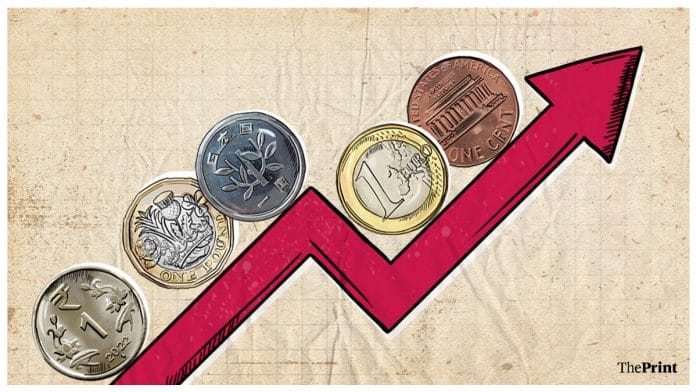In a move that surprised many observers, the Reserve Bank of India’s Monetary Policy Committee Thursday decided to keep the repo rate unchanged at 4 per cent and the reverse repo rate at 3.35 per cent. The MPC also decided to continue with the accommodative stance for as long as is needed to revive and sustain growth. The policy seems to have given primacy to keeping the government’s cost of borrowing low at a time when global central banks are on the path to normalising their ultra-accommodative monetary policy and hiking interest rates amid a resurgence of inflationary pressures.
Central banks fast-tracking policy normalisation
Central banks globally have started normalising monetary policy sooner than anticipated amid a rise in inflation. The US Federal Reserve in its meeting held on 25-26 January indicated that it could start raising interest rates as soon as March. The Fed Chairman indicated that asset purchases are also likely to halt in March. The Committee’s statement came in response to inflation in the US surging to 7 per cent — the highest level in nearly 40 years.
Meanwhile, the Bank of England announced its second consecutive interest rate hike in three months — a quarter-point increase to 0.5 per cent. The move was in response to inflation in the UK rising to 5.4 per cent in December. It is projected to peak at 7.25 per cent in April.
Also read: Jobs in formal sector, bond market reforms — how Budget 2022 should respond to K-shaped recovery
Indian context
The fiscal expansion to support economies during the pandemic was much more pronounced in advanced economies, where it led to a strong revival of demand. Coupled with supply-side bottlenecks, this led to a rise in inflation. However, in India, the policy response to the pandemic was relatively light on fiscal measures. Support came mainly in the form of directed credit to businesses backed by a sovereign guarantee, and a boost to capital spending. We did not see a fiscally induced bump up in demand, as occurred in advanced economies.
Gradual monetary policy normalisation
While monetary policy maintained that support was needed for growth, the RBI embarked on a gradual normalisation of monetary policy. In October 2021, it stopped its G-sec (government security) purchases through the G-sec Acquisition Program (G-SAP) and started conducting Variable Reverse Repo Rate (VRRR) auctions to withdraw excess liquidity. In a reverse repo transaction, banks park their excess funds with the RBI and get paid an interest. A part of it is done at a fixed rate and some of it at a variable rate.
In a variable rate reverse repo transaction, interest rates are determined through auctions. Since October 2021, VRRR auctions have become the primary tools of liquidity management. In the December monetary policy announcement, the RBI hiked the amount it absorbed through VRRR auctions. It also announced various tenors of VRRR auctions: three-day, seven-day and 14-day. As a result, short-term money market rates have inched closer to the repo rate.
Also read: Keep calm & continue reform — mantra for Modi govt and RBI as Indian economy braces for 2022
Formalising monetary policy normalisation amidst rise in inflation
In Thursday’s meeting, it was expected that the RBI would “formalise” its monetary policy normalisation by announcing a 20-basis point hike in the reverse repo rate, bringing it into alignment with other short-term rates.
While the RBI has projected 4.5 per cent inflation for the next fiscal, this seems to be too optimistic. The hardening of global crude oil prices presents a major upside risk to inflation. The transmission of input cost pressures could gather momentum as demand revives amid a decline in Omicron cases. Core inflation remains elevated at 6 per cent.
Further, a rise in rates could have widened the spread between the Indian and US bond yields, which has been narrowing due to a rise in the latter. This, to some extent, could have attracted the inflow of foreign funds to the Indian markets.
Nervousness in the bond market
The RBI’s reluctance to hike rates seems to have been driven by the challenge of managing the government’s higher-than-expected borrowing programme for the next year. The Budget announced a gross market borrowing of Rs. 14.95 lakh crore for the next financial year. High borrowing numbers resulting in a possible supply-demand mismatch and the absence of steps to include domestic bonds in the global bond indices pushed the bond yields to record 6.9 per cent after the budget announcement. A formal announcement of a hike in the interest rate would have meant the RBI was catching up with markets.
In the absence of a dedicated debt management agency, there is an inherent conflict between managing the government’s debt and inflation. In the absence of a debt management agency, the RBI runs the risk of falling behind the curve in managing inflationary expectations. This will reduce the central bank’s credibility and make markets more jittery. Under such conditions, volatility induced by changes in Fed rates, oil price hikes, or any other shocks could induce turbulence in currency and money markets.
Ila Patnaik is an economist and a professor at National Institute of Public Finance and Policy.
Radhika Pandey is a consultant at NIPFP.
Views are personal.
Also read: Low rates are for short-term. RBI must raise rates to help household savings as inflation rises






